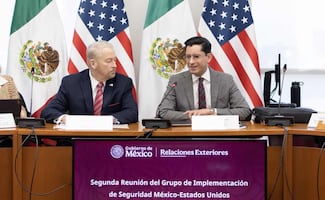Más Información

Chocan Rojo de la Vega y Fernández Noroña por pensión del bienestar; “¿le alcanzó para comprar su casa millonaria de Tepoztlán?”

Dan 14 años de cárcel a "El Patrón", autor intelectual del atentado contra Ciro Gómez Leyva; asegura recibió órdenes del CJNG

México reitera que acepta responsabilidad en el caso de Ernestina Ascencio; analizará razonamientos de la Corte Interamericana

Coche bomba que estalló en Coahuayana, fue accionado a distancia: fiscal de Michoacán; rostros de probables responsables están ubicados, dice

¿Qué acordaron México y EU en la segunda reunión de Seguridad?; armas, huachicol y extradiciones los temas claves
On October , U.S. President Donald Trump said that U.S. steel and aluminum tariffs would remain in place for Canada and Mexico until they “can do something different like quotas, perhaps.” However, no change has been made so far.
Mexico’s Steel Producers Association (CANACERO)
informed of a drop in steel production and exports from Mexico to the U.S. last October , due to “an artificial measure that is frankly inconsistent with the principles of free trade and sets a dangerous precedent that infringes its guidelines.”
Since June 1, 2018, the United States applied a tariff of 25% on Mexico, Canada, and Europe’s steel imports . As a retaliatory measure, Mexico taxed several products, including 50 tariff fractions that encompassed steel products, food, and consumer goods .
The Mexican government is now preparing a strategy to negotiate the elimination of tariffs on steel and aluminum imposed by the United States, and will work on the ratification of the new North American Trade Agreement (USMCA) , said the new Minister of Economy, Graciela Márquez Colin .
In her first meeting with media representatives after taking office, the official said that the neighboring country of the north used this mechanism under section 232 for national security reasons , however "we are not a threat," she stressed.
She reiterated that Mexico had expressed its dissatisfaction since the imposition of these tariffs on June 1 , when the government of Donald Trump placed a tax of 25 percent on steel and 10 percent on aluminum to put pressure on Mexico during the renegotiation of NAFTA.
dm
Noticias según tus intereses
[Publicidad]
[Publicidad]










